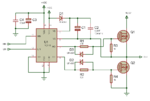Logu KS
Member level 2
I need to switch 230v dc supply from the capacitor bank to load in clock wise and anti-clockwise direction (when the q1 and q3 igbts are ON the load should get +230v and when the q2 and q4 gbts are ON the load should get -230v from the capacitor bank).
The IGBT i am going to use is G160N60. I want to know which driver is suitable for performing the above mentioned operation. The H Bridge will be formed using the IGBT's.
As i am new to the power electronics i need guidance from the members of the forum.
The IGBT i am going to use is G160N60. I want to know which driver is suitable for performing the above mentioned operation. The H Bridge will be formed using the IGBT's.
As i am new to the power electronics i need guidance from the members of the forum.

